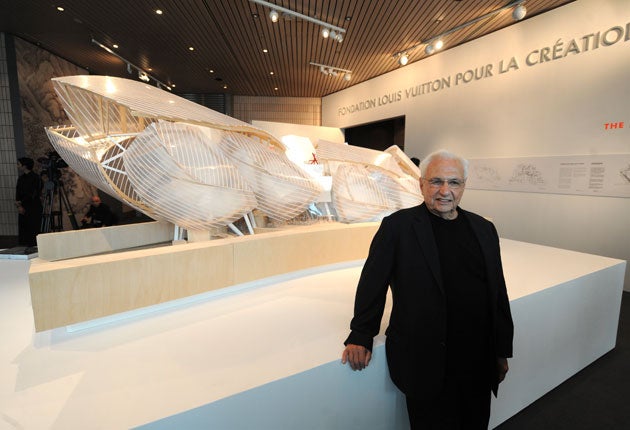Parisian residents halt Gehry building

Your support helps us to tell the story
From reproductive rights to climate change to Big Tech, The Independent is on the ground when the story is developing. Whether it's investigating the financials of Elon Musk's pro-Trump PAC or producing our latest documentary, 'The A Word', which shines a light on the American women fighting for reproductive rights, we know how important it is to parse out the facts from the messaging.
At such a critical moment in US history, we need reporters on the ground. Your donation allows us to keep sending journalists to speak to both sides of the story.
The Independent is trusted by Americans across the entire political spectrum. And unlike many other quality news outlets, we choose not to lock Americans out of our reporting and analysis with paywalls. We believe quality journalism should be available to everyone, paid for by those who can afford it.
Your support makes all the difference.A strange sense of architectural déjà vu has gripped the French capital. Parisians, who in their day loathed the Eiffel Tower, the Pompidou Centre and the Louvre Pyramid, are campaigning once again to defeat a revolutionary new building.
This time they may succeed. Work on the "cloud of glass" – a building designed by the Canadian-American architect Frank Gehry, which resembles a squashed lampshade – has been halted by a court ruling.
The city of Paris has appealed. If the appeal fails, the partly built €100m (£86m) museum and gallery for the world's largest luxury goods company, LVMH, will have to be torn down.
Gehry, 81, who designed Bilbao's Guggenheim Museum and is one of the most admired architects in the world, was said yesterday to be "distressed, shocked and furious" at the threat to his "magical" creation.
The French architect Jean Nouvel, speaking on Mr Gehry's behalf, said the architect was "outraged by the selfishness, lack of civic pride and ignorance" of a wealthy Parisian residents' group which brought the successful court action. "The history of Paris is the history of its architecture," Mr Nouvel said. "Within a few years this unique, ethereal structure will be declared a national monument."
The Fondation LVMH has been under construction for more than a year close to the Jardin d'Acclimatation, a children's fairground on the northern edge of the Bois de Boulogne park. The concrete core of the building is almost complete. After a series of complaints by a residents' group, an administrative tribunal decided last month that the museum should never have been given a building licence.
The tribunal rejected the residents' claim that, at 46m, the building was too tall. The court ruled, however, that it blocked a public road through the large, forested park on the western edge of the city. The Mayor of Paris, Bertrand Delanoë, said the ruling was absurd. The so-called pathway or road, although marked on old maps, was notional and had not been used by the public for years, he said. The LVMH foundation was a "work of global importance", which must be allowed to go ahead, he said.
François Douady, the president of the Coordination de Sauvegarde du Bois de Boulogne, said his members had nothing against the building so long as it was moved elsewhere. "We want to defend the Bois de Boulogne from a tide of concrete," he said.
Mr Douady's critics point out that the Fondation LVMH will replace a defunct bowling alley, constructed in the 1950s from wood, polystyrene, formica, plastic and concrete. Not a single tree has been felled to make room for the museum. The residents' group is also campaigning against plans to extend the Roland Garros tennis complex, at the southern end of the park, and to build council flats near the eastern edge of the woodland at Porte d'Auteuil. The Socialist-run town hall suggests that the wealthy members of the group are motivated mostly by selfishness and snobbishness.
To this Mr Douady said: "We may not be poor but we are middle-class people who have slogged all our lives to make sure our kids go to good schools and have decent homes".
The Fondation LVMH is the brainchild of the company's founder, Bernard Arnault, who is the wealthiest man in France. It will house his personal art collection, art exhibitions and displays of historical artefacts connected with the companies in the LVMH group, which include luxury brands Louis Vuitton, Christian Dior, Moet-Hennessy, Givenchy and De Beers.
The project was announced in 2006, just after Mr Arnault's great rival, François Pinault – the owner of Gucci and other brands – opened his own arts foundation in Venice. Mr Pinault had originally intended to build his modern art museum on an island in the Seine west of Paris, previously occupied by a Renault factory. After a series of planning delays, he shifted the project to Italy.
Parisian resistance to ground-breaking architectural design dates back to the late 19th century. There were petitions to stop the "useless and monstrous" Eiffel Tower in 1887. The brightly coloured Pompidou Centre, with ducts and pipes exposed, caused intense anger in 1969. Twenty years' later, there were unsuccessful campaigns to stop the building of the glass pyramid in the Louvre courtyard which has transformed access to the world's largest art museum.
When he outlined his design for the building in 2006, Mr Gehry said: "It's a cloud of glass – magical, ephemeral, all transparent. I wanted to create something that every time you approach, it shows a different character depending on the light and the time of day."
Join our commenting forum
Join thought-provoking conversations, follow other Independent readers and see their replies
Comments